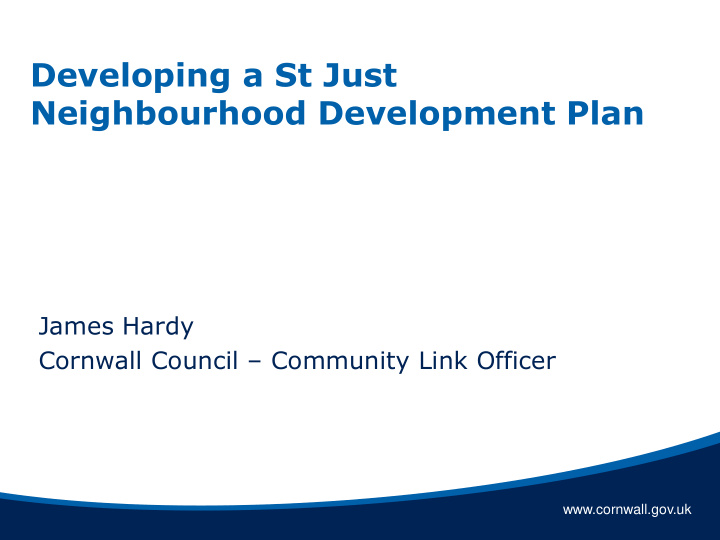



Developing a St Just Neighbourhood Development Plan James Hardy Cornwall Council – Community Link Officer www.cornwall.gov.uk
The Cornwall Local Plan The Cornwall Local Plan sets out our planning approach, policies and how we will manage development to 2030. The Local Plan sets out a vision for growth and identify the quantity and broad location and key sites, for new housing, community facilities, shops and employment. If we don’t have a Local Plan, development will still happen, but decisions will be taken in regard to the National Planning Policy Framework without local people having a say on setting local policies. Neighbourhood Plans, prepared by city, town and parish councils will be part of the statutory Plan too. . www.cornwall.gov.uk
www.cornwall.gov.uk
Why develop a St Just Neighbourhood Plan? • The total for the CNA area is 3150, of these, 2150 are allocated to Penzance (inc. Newlyn, Heamoor, Gulval and Longrock) so there is a residual allocation of 1000 houses for the remainder of the Community Network Area. www.cornwall.gov.uk
What is a Neighbourhood Development Plan? • Neighbourhood Plans allow people to come together through a local Parish/Town Council and say where they think new houses, businesses and shops should go, and what they should look like. • Neighbourhood Plans can be very simple, or go into considerable detail: • Full development plan dealing with land use planning issues for the parish area • Sets out policies in relation to development and use of land in a neighbourhood • Express local priorities • Allocate sites for housing and other development • Identify important green spaces www.cornwall.gov.uk
What can Neighbourhood plans do? • Neighbourhood plans must: • Be permissive • Be about land use planning • Be produced by the community • Neighbourhood Plans cannot: • Conflict with local or national policy • Propose less growth than strategic plan www.cornwall.gov.uk
www.cornwall.gov.uk
Who can produce a Neighbourhood Plan? • The Localism Act specifies that only a ‘Qualifying Body’ is entitled to initiate and lead the production of a Neighbourhood Plan (Under Section 38A (12) of the Act). In Cornwall this is the Parish Council. • The Qualifying Body will require a formal constitution which sets out its aims, structure and decision making processes for the Neighbourhood Plan. www.cornwall.gov.uk
The Parish Boundary Designated Area www.cornwall.gov.uk
Getting Started • Public meeting • What do we already know? • Is a neighbourhood plan the way forward? • Formal request to Cornwall Council to designate area Map identifying the area Statement explaining the area Statement explaining that the body making the area application is a qualifying body under the Localism Act 2011 www.cornwall.gov.uk
Key Tasks • Holding an early community event to get people involved - to make sure it is a genuinely community-led process (referred to as legitimisation). • Getting a core group together to organise the work and to make sure the right steps are followed. • Setting up task groups to gather information about certain themes and to make recommendations back to the core group. • Pulling it all together with the whole community and agreeing local priorities. • Writing the plan – simple policy that reflects those priorities and defining local projects. • Getting formal approval for the plan (independent inspection) • Referendum ……and then making it happen! www.cornwall.gov.uk
Cornwall Council Support • Community link officer – initial options, funding, project planning and engagement • Neighbourhood planning officer – project support, consultations, plan development, evidence base, policy writing, • Toolkit and guide notes • Neighbourhood Planning Mailbox neighbourhoodplanning@cornwall.gov.uk • Training and group meetings • Maps and data/statistics www.cornwall.gov.uk
Process www.cornwall.gov.uk
Statutory process www.cornwall.gov.uk
Costs • Average cost estimated by DCLG: £20,000 to £86,000 per plan. • Plans will vary in cost depending on the issues and type of area covered, and complexity • Smaller more focussed plans will cost less! • Therefore ‘scoping’ is really important. www.cornwall.gov.uk
• Core Costs to a local council • Engagement and consultation costs : Planning for Real type events: £1,500 to £5,000 • Publicity and production of plans £1,500 to £2,500 • Project management and ‘footwork’ £nil to £10,000 Additional Costs to a local council • Non-statutory assessments: • Retail Impact assessment: £3,000 to £7,000 • Equalities Impact assessment: £Nil to £2,000 • Community safety assessment: £2,000 to £5,000 • Flood risk assessment £2,000 to £5,000 • Environmental Impact Assessment: up to £75,000 • Strategic Environmental Assessment: £10,000-£30,000 • Habitats Regulations Assessment: typically £15,000 • Master- plan type documents: £50,000/1yr consultants’ fees www.cornwall.gov.uk
Examples of Costs • A basic small village plan: £5,000 - £10,000 • St Somewhere: £9,800 • Small Town: (including an SEA, Retail, Flood Risk Assessment): £40,000 - £75,000 • City: £200,000+ • Town Centre or Employment area: £20,000 www.cornwall.gov.uk
Cornwall Council Costs • Officer support providing expertise and advice • Process and advertisement costs • Examination costs - £2,000 to £10,000 • Referendum costs - £2,000 to £30,000 • Loss of income from planning application fees www.cornwall.gov.uk
Neighbourhood Planning Toolkit www.cornwall.gov.uk
What can you bring to the table? Planning experience/expertise, Policy writing, Project Management, Chairmanship, Graphic design, Marketing / market research, Proof reading, Presentation skills, Knowledge of the local area…… www.cornwall.gov.uk
? www.cornwall.gov.uk
Recommend
More recommend